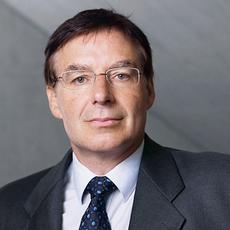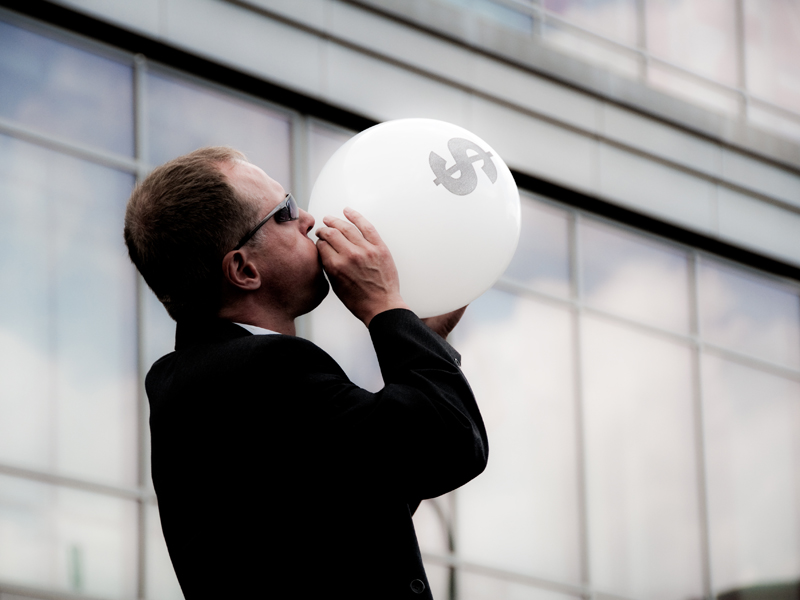The Financial Bubble Experiment
Professor Didier Sornette from the Department of Management, Technology and Economics (D-MTEC) at ETH Zurich is convinced that financial markets are not just random. Consequently, his Financial Crisis Observatory conducted a daring experiment to prove that you can forecast financial bubbles. Today, Professor Sornette presented the results of the experiment at a press conference.

Professor Didier Sornette from the Department of Management, Technology and Economics (D-MTEC) at ETH Zurich is convinced that financial markets are not just random. Consequently, his Financial Crisis Observatory conducted a daring experiment to prove that you can forecast financial bubbles. Today, Professor Sornette presented the results of the experiment at a press conference.
Didier Sornette, Professor of Entrepreneurial Risks at ETH Zurich, has two hypotheses: firstly, bubbles can be diagnosed in real time before they end; secondly, the termination of these bubbles can be bracketed using probabilistic forecasts with a reliability better than chance. As a controversial debate surrounds the two hypotheses and proof was needed, Professor Sornette and his team from the Financial Crisis Observatory (FCO) launched an extraordinary experiment: they forecast that four selected assets would form a bubble in the following six months, and when this would happen. To guarantee the seriousness and integrity of the experiment, the forecasts were announced and encoded.
As yet, nobody has any reliable quantitative methods to ascertain whether the market or a particular asset is in a bubble state. One problem here is that none of the various economic theories and models provides a universal and quantifiable definition of a bubble. New, multidisciplinary approaches are therefore needed in the face of the complexity of the financial market. Consequently, Didier Sornette works with a portfolio of methods from very different fields, such as economics, physics and mathematics.
Identifying "regime shifts"
The results of the Financial Bubble Experiment (FBE) show that the dynamics of financial markets actually exhibit an identifiable structure. And that's not all; the results also prove that the dynamics of financial markets are subject to a so-called "regime shift". This means that phases of strong growth are replaced by ones only exhibiting moderate growth or even declines, or vice versa. A crash is an extreme example of a regime shift. The following data was used in the FBE as indicators of a regime shift: firstly, the scale of the drop in prices; secondly, the proportion of "good days" (positive return days); and thirdly, the growth rate of the price.
The assets selected
Out of all the assets observed by the FCO, the scientists selected the four for which they expected such a shift within the following six months: IPOVESPA Brazil Index, the Merrill Lynch bond index, the gold spot price and cotton futures. The forecasts for the first three assets were announced on November 23 2009; that for the cotton futures on December 23 2009.
In accordance with Sornette's theory, the four assets exhibited a clear regime shift. As a static fuzziness is inherent in the system (see box), the FCO states its forecasts in the form of probabilities and within two time windows. In the one, the turning point is anticipated with a 60% probability; and in the second, with a 90% probability.
Forecasts and results
Sure enough, all four assets exhibited a regime shift either within the forecasted time window (Brazil IBOVEST, gold and cotton) or shortly before it (Merrill Lynch corporate index). By November 2 2009 there were already bubbles in two of them (IBOVESPA and gold).
Brazil IBOVEST
Forecast: between 10.19.2009 and 12.17.2009 the probability of a regime shift is 95%; between 10.27.2009 and 11.29.2010 it is 60%. Result: the regime shift began within the forecast window. Within this window, the proportion of "good days" started with a peak and declined steeply; also within the window, the growth rate of the price dropped sharply. A large draw-down of 11% in 30 days occurred approximately two weeks after the end of the forecast window.
Merrill Lynch bond index
Forecast: between 10.11.2009 and 2.9.2010 the probability of a regime shift is 95%; between 10.27.2009 and 1.16.2010 it is 60%. Result: the regime shift already began 1-2 months before the forecast window. It was confirmed that the Merrill Lynch Index had been in a bubble, but that it had ended before the start date. It was only detected in retrospect on account of the analysis conducted in the last six months. The recently developed bubble index confirms that the asset was actually coming out of the bubble. Today, the asset definitely is no longer in a bubble.
Gold
Forecast: between 10.13.2009 and 9.7.2010 the probability of a regime shift is 95%; between 11.5.2009 and 2.25.2010 it is 60%. Result: the regime shift occurred within the forecast window: the price dropped by 11% in 20 days and 13% in 68 days in all. The other indicators confirm this.
Cotton
Forecast: between 12.5.2009 and 4.9.2010 the probability of a regime shift is 95%; between 12.31.2009 and 3.16.2010 it is 60%. Result: the metrics implemented thus far did not yield any clear conclusions for the price of cotton future. However, the research team's bubble index did diagnose an existing and intensifying bubble. The moment of the cotton drawdown (12% in 30 days) happened within the forecast window. This can be perceived as a partial success or a failure, however, since the FOC's present indicators say that the bubble has not yet ended; this suggests that a "baby bubble" was identified and is still growing.
Evaluation of the experiment
This test is the first in a whole range of experiments. The results obtained are intended to be used in further experiments. First and foremost, the scientists are looking to refine the diagnosis methods and metrics, and improve the selection algorithm. "We'll continue to conduct experiments at regular intervals", explains Professor Sornette. "Next week, we're publishing new forecasts for seven new financial bubbles. These experiments will be based on better metrics because we'll have recourse to the new results we obtained in the last six months."
Furthermore, assets that are candidates for a regime shift are also to be determined fully automatically in future. Until now, the researchers have had to provide an individual expert report. They have already succeeded in developing suitable filters and implementing them in the new algorithms, which are necessary to scan large quantities of assets and identify bubbles.
As the traditional economy follows the paradigm of the fundamental unpredictability of the financial markets, the FBE could trigger a paradigmatic shift: "The financial crisis was regarded as unpredictable, and consequently no one was blamed; this suited many down to the ground. If we can prove we're right, how-ever, the textbooks will have to be rewritten", says Professor Sornette.
Mr. Sornette, are you able to recognize bubbles
on the financial market before they burst?
That’s the first of the two hypotheses we tested with the financial
bubble experiment. Whilst the results support the hypothesis, they aren’t
proof. The second hypothesis is that the moment a financial bubble bursts can
be predicted. I think this will also be supported, but we’ll let people judge
for themselves.
What are the next steps with the financial
bubble experiment?
To continue with
the tests. We’re constantly refining the method and have already made some
major progress over the last six months. The aim is to achieve better risk
management.
In the nineties you patented a method to
predict material cracks in rockets. Are you also aiming for a patent this time?
No, I have no intention of doing so this time around. If you want to
patent something, you have to disclose your methods, but we keep some of the
technical know-how to ourselves. For us, it’s a measure of our success how many
financial institutions and experts have contacted us to work with us. They also
spur our research on with their questions.
Six months ago, you recorded your prognoses in
the encrypted document you’re publishing today. Why did you choose this unusual
form of publication?
This method offers complete transparency; no one can claim that we only
publish successful predictions whilst keeping the failures under wraps. And we
wanted to establish a procedure that hopefully others will adopt.
Weren’t you jeopardizing your integrity as a
scientist with this method?
Yes, I was putting my reputation on the line somewhat, but I wasn’t
really worried. We spent over 15 years developing the theory behind the
financial bubble experiment and have already published numerous results in
traditional forms.
Why are most of your colleagues critical of
your hypotheses?
For various reasons; firstly, the word “prediction” sounds dubious to a
scientist as there’s a multitude of unscientific predictions of the future out
there; secondly, many people have already tried in vain to detect financial
bubbles and predict when they’ll burst; thirdly, we work with a set of methods
from very different fields, like economics, physics and mathematics, which
makes it very difficult for experts from the individual subject areas to
understand our research; finally, if our hypotheses ultimately prove to be true
it’ll be awkward for many people. It would trigger paradigmatic shift. After
all, the financial crisis was thought to be unpredictable and thus no one was
blamed; this suited many down to the ground.
Apart from financial bubbles, you also work out
prognoses for events as diverse as earthquakes, epileptic fits and cracks in
materials. Which fields will your research be focusing on in the future?
The research in the various fields runs in parallel. The focus will
continue to be the financial bubble experiment. However, I’m also very
interested in epileptic fits, and I would like to branch out into predicting
the time of birth. When the wife of one of the research assistants in my team
recently found out she was pregnant, at the couple’s suggestion we started
preparations for the measurements. However, we didn’t go through with them in
the end because it would have taken up too much time and effort to manage the
project in parallel with the financial bubble experiment.
What are the similarities between financial
bubbles and the time of birth?
Both involve modeling collective behavior. The behavior of a single stock
exchange speculator cannot be predicted, but predictions can be made
collectively for all speculators. That also goes for the muscle cells in the
uterus: it’s their collective behavior that initiates labor. Collective
behavior is also responsible for the outbreak of diseases, as you reported in
ETH Life; I’d also like to do some more
research here.
Along with the financial world, are you also
interested in the health sector?
Yes, I’m fascinated by the fact that there is an intrinsic conflict of
interests in both areas. Banks primarily aren’t interested in the investor’s
investments, but in profits for the bank’s shareholders. And it’s even worse in
health care: it’s in the interests of doctors and the pharmaceutical industry
for people to be marginally sick as this means they need medical care. What
goes on in the health care system really infuriates me. It is no secret what it
takes to stay healthy: diet, meat no more than twice a week, lots of vegetables,
and so on.
You keep in trim by going jogging and working
out on the machine in the office. And yet you also engage in sports with a high
risk of injury, like skiing and motorcycling. Isn’t that a contradiction?
I’m very conscious of the risks. Take me as a motorcyclist for instance:
in California I owned the most powerful motorbike around at the time, but when
I’m on the bike I’m fully focused – something I’m very good at as a professor;
I watch the road, scrutinize the surface of the road and the people on the roadside,
and if the lights turn green for me I don’t automatically assume they’re red
for the others.
Have you ever been involved in an accident?
No; never.
And I’ve been riding for twenty years now. That’s dynamic risk management.








READER COMMENTS